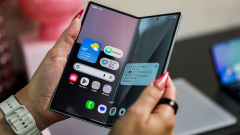In 2014, Apple and Samsung were duking it out to rule the U.S. smartphone market. Samsung was selling devices with large screens, and iPhone fans were demanding a response.
It took Apple some time, but the company finally released the iPhone 6, breaking with previous iterations and giving consumers a large-screen option. The iPhone won.
But more than a decade later, recent smartphone sales and shipment figures signal that the Apple-Samsung fight has returned. And once again, it’s all about the screen.
In the second quarter, shipments from Samsung surged in the U.S., with its market share rising from 23% to 31% from the prior period, according to data from Canalys. Apple’s market share during the quarter declined to 49% from 56%.
Apple remains on top of the U.S. smartphone market, taking the majority of new smartphone sales in the U.S. It’s often in second place around the world, but the recent slips points to turbulence for Apple for the first time in well over a decade.
That’s one reason investors have sent Apple shares down 7.5% this year, underperforming all of the U.S. megacap tech companies other than Tesla. Samsung’s stock, meanwhile, is up about 35% in 2025.
Apple reported a 13% increase in year-over-year iPhone sales in its July earnings.
In July, Samsung introduced a pair of innovative new phones that feature foldable screens. One model, the Z Fold 7, can effectively turn into a tablet, while the Z Flip resembles an old-school flip phone with modern smartphone features. They were added to Samsung’s catalog of phones released this spring under its Galaxy brand, including a thin-and-light phone called the Galaxy S25 Edge.
The devices are also getting a lot of traction on social media, particularly around durability tests.
One user posted a livestream that showed him bending the Z Fold 7 over 200,000 times in a row. The video has been clipped and shared widely on social media, with one version of the clip accumulating more than 15 million views on YouTube.
In the past month, Samsung’s premium devices, including the Z Fold 7, were mentioned over 50,000 times on social media, and 83% of those mentions were positive or neutral, according to data from Sprout Social, a social media analytics company.
The market share numbers aren’t just the result of user preferences. Much of the shift in shipment figures in the June quarter, analysts said, can be attributed to tariffs, which are causing “disruption” in the industry as smartphone makers use different strategies to minimize the impact on their business.
But Samsung’s gains also reflect the company’s ability to offer a much wider range of products at different prices compared to Apple. That includes low-end phones, which accounted for much of Samsung’s second-quarter U.S. improvement, as well as high-end devices that cost more than any individual iPhone.
Samsung’s Galaxy and Z phone lineup “stretches from $650 up to $2,400. That is a massive span of devices,” said Canalys analyst Runar Bjorhovde. “There is an idea that you can target people at every single price point, and you can meet them at every spot.”
The iPhone has pretty much looked the same since 2017 — a rectangular piece of glass with a touchscreen on the front, and a few cameras on the back. These days, the company offers a series of four slates ranging from $829 to $1,599. Samsung and others are starting to go beyond the so-called candy bar shape and experimenting with new form factors.
Apple is expected to start doing the same — beginning with a potential launch next month of a slimmer iPhone that will compete with Samsung’s Galaxy Edge.
“Apple is clearly betting that its 5.5m





